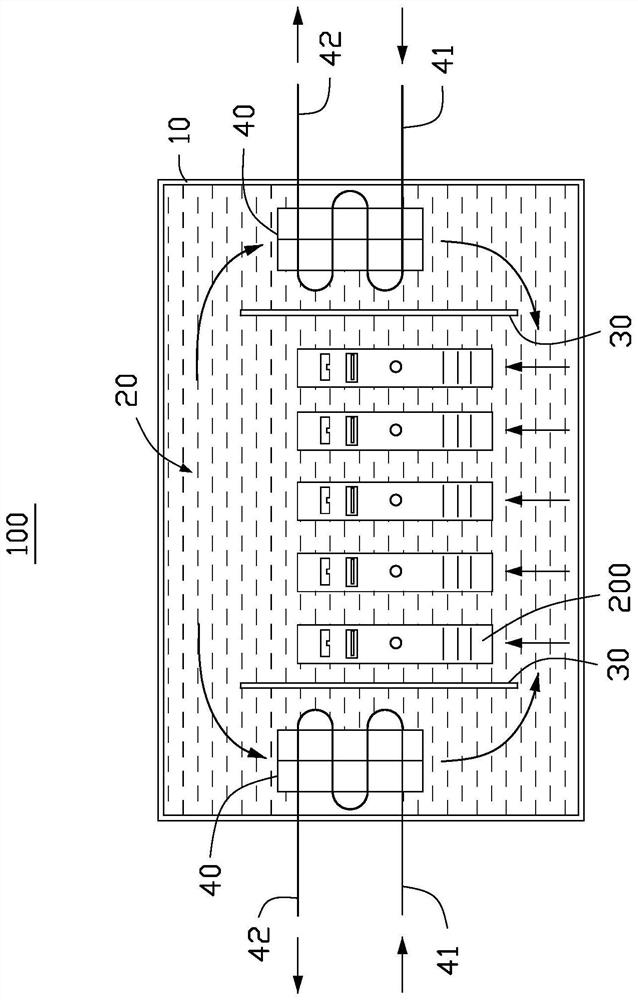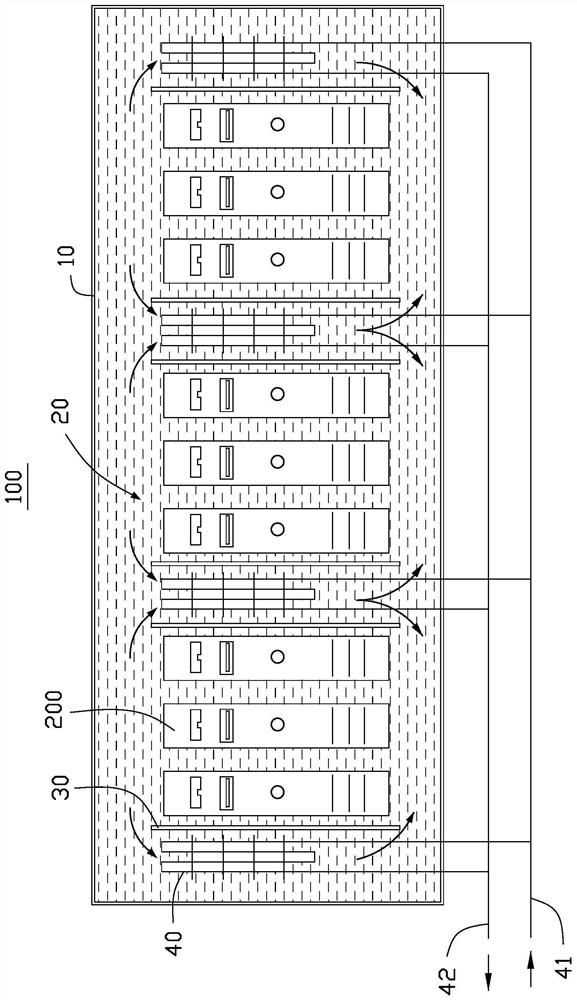Immersed cooling device
A cooling device, immersion technology, applied in the direction of cooling/ventilation/heating renovation, electrical components, electrical equipment structural parts, etc. cost saving effect
- Summary
- Abstract
- Description
- Claims
- Application Information
AI Technical Summary
Problems solved by technology
Method used
Image
Examples
no. 1 example
[0036] See figure 1 This embodiment provides an immersion cooling device 100 for cooling the electronic device 200. Further, the electronic device 200 is a server. It can be understood that, in other embodiments, the electronic device 200 may also be other devices that need to be cooled.
[0037] See figure 1 The immersion cooling device 100 includes a tank 10 for holding an insulating cooling liquid 20 to soak the electronic device 200. The immersion cooling device 100 further includes a partition 30 and a heat exchanger 40. The partition 30 is arranged in parallel with the electronic device 200, the partition 30 and the heat exchanger 40 are arranged inside the tank 10, and the heat exchanger 40 is placed in the tank 10 The electronic devices 200 are respectively disposed on opposite sides of the partition 30, and the partition 30 is used to guide the flow direction of the insulating cooling liquid 20.
[0038] The insulating cooling liquid 20 flows in different directions due...
no. 2 example
[0048] See figure 2 The structure of the second embodiment is basically similar to that of the first embodiment. However, the difference between the second embodiment and the first embodiment is that the immersion cooling device 100 is provided with multiple sets of partitions 30 and heat exchangers 40. Wherein, the cold water port 41 and the hot water port 42 on the plurality of heat exchangers 40 are connected in series to form a connected pipeline, which passes through the heat exchanger 40 on the edge of the tank 10 The cold water port 41 and the hot water port 42 are connected to an external supply device.
[0049] Through the above-mentioned serial communication mode, the cold water port 41 and the hot water port 42 of the heat exchanger 40 do not need to be connected to the external supply device separately, which simplifies the connection between the submerged cooling device 100 and the external supply device. The connection between.
no. 3 example
[0051] See image 3 The structure of the third embodiment is basically similar to that of the second embodiment. However, the difference between the third embodiment and the second embodiment is that the cold water ports 41 and hot water ports 42 on the multiple heat exchangers 40 are connected in series, and then the cold water ports 41 that form a pipeline after being connected in series are designed as At the same time, the hot water port 42 that forms a pipeline after being connected in series is also designed in a ring shape. The cold water port 41 and the hot water port 42 on the two heat exchangers 40 near the edge of the tank 10 are connected to an external supply device.
[0052] After the cold water port 41 and the hot water port 42 on the heat exchanger 40 are connected in series, a ring design is adopted. When one of the heat exchangers 40 fails, the cooling water provided by the external supply device can also flow in or out from the other direction of the annular d...
PUM
 Login to View More
Login to View More Abstract
Description
Claims
Application Information
 Login to View More
Login to View More - R&D
- Intellectual Property
- Life Sciences
- Materials
- Tech Scout
- Unparalleled Data Quality
- Higher Quality Content
- 60% Fewer Hallucinations
Browse by: Latest US Patents, China's latest patents, Technical Efficacy Thesaurus, Application Domain, Technology Topic, Popular Technical Reports.
© 2025 PatSnap. All rights reserved.Legal|Privacy policy|Modern Slavery Act Transparency Statement|Sitemap|About US| Contact US: help@patsnap.com



